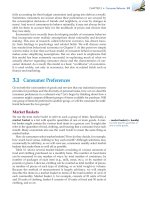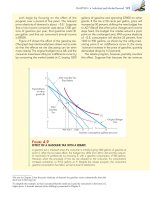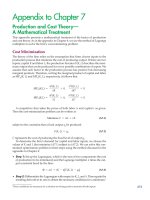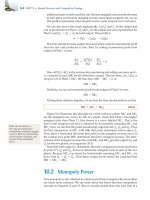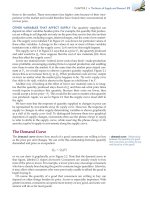(8th edition) (the pearson series in economics) robert pindyck, daniel rubinfeld microecon 259
Bạn đang xem bản rút gọn của tài liệu. Xem và tải ngay bản đầy đủ của tài liệu tại đây (71.17 KB, 1 trang )
234 PART 2 • Producers, Consumers, and Competitive Markets
years—nearly all costs are variable. Workers and managers can be laid off (or
employment can be reduced by attrition), and much of the machinery can be
sold off or not replaced as it becomes obsolete and is scrapped.
Knowing which costs are fixed and which are variable is important for the
management of a firm. When a firm plans to increase or decrease its production, it will want to know how that change will affect its costs. Consider, for
example, a problem that Delta Air Lines faced. Delta wanted to know how its
costs would change if it reduced the number of its scheduled flights by 10 percent. The answer depends on whether we are considering the short run or the
long run. Over the short run—say six months—schedules are fixed and it is difficult to lay off or discharge workers. As a result, most of Delta’s short-run costs
are fixed and won’t be reduced significantly with the flight reduction. In the
long run—say two years or more—the situation is quite different. Delta has sufficient time to sell or lease planes that are not needed and to discharge unneeded
workers. In this case, most of Delta’s costs are variable and thus can be reduced
significantly if a 10-percent flight reduction is put in place.
Fixed versus Sunk Costs
People often confuse fixed and sunk costs. As we just explained, fixed costs are
costs that are paid by a firm that is operating, regardless of the level of output
it produces. Such costs can include, for example, the salaries of the key executives and expenses for their office space and support staff, as well as insurance
and the costs of plant maintenance. Fixed costs can be avoided if the firm shuts
down a plant or goes out of business—the key executives and their support
staff, for example, will no longer be needed.
Sunk costs, on the other hand, are costs that have been incurred and cannot
be recovered. An example is the cost of R&D to a pharmaceutical company to
develop and test a new drug and then, if the drug has been proven to be safe
and effective, the cost of marketing it. Whether the drug is a success or a failure,
these costs cannot be recovered and thus are sunk. Another example is the cost
of a chip-fabrication plant to produce microprocessors for use in computers.
Because the plant’s equipment is too specialized to be of use in any other industry, most if not all of this expenditure is sunk, i.e., cannot be recovered. (Some
small part of the cost might be recovered if the equipment is sold for scrap.)
Suppose, on the other hand, that a firm had agreed to make annual payments
into an employee retirement plan as long as the firm was in operation, regardless
of its output or its profitability. These payments could cease only if the firm went
out of business. In this case, the payments should be viewed as a fixed cost.
Why distinguish between fixed and sunk costs? Because fixed costs affect the
firm’s decisions looking forward, whereas sunk costs do not. Fixed costs that
are high relative to revenue and cannot be reduced might lead a firm to shut
down—eliminating those fixed costs and earning zero profit might be better
than incurring ongoing losses. Incurring a high sunk cost might later turn out
to be a bad decision (for example, the unsuccessful development of a new product), but the expenditure is gone and cannot be recovered by shutting down. Of
course a prospective sunk cost is different and, as we mentioned earlier, would
certainly affect the firm’s decisions looking forward. (Should the firm, for example, undertake the development of that new product?)
AMORTIZING SUNK COSTS In practice, many firms don’t always distinguish between sunk and fixed costs. For example, the semiconductor company
that spent $600 million for a chip-fabrication plant (clearly a sunk cost) might

